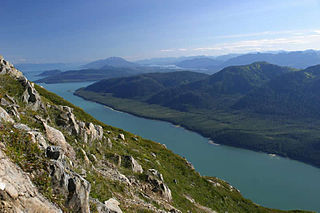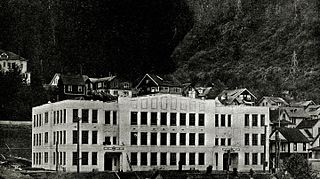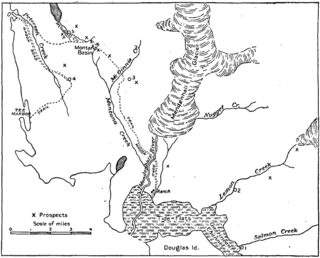
Juneau, officially the City and Borough of Juneau, is the capital of the U.S. state of Alaska, located along the Gastineau Channel and the Alaskan panhandle. Juneau was named the capital of Alaska in 1906, when the government of what was then the District of Alaska was moved from Sitka as dictated by the U.S. Congress in 1900. On July 1, 1970, the City of Juneau merged with the City of Douglas and the surrounding Greater Juneau Borough to form the current consolidated city-borough, which ranks as the second-largest municipality in the United States by area and is larger than either Rhode Island or Delaware.

Douglas Island is a tidal island in the U.S. state of Alaska. It is part of the city and borough of Juneau, just west of downtown Juneau and east of Admiralty Island. It is separated from mainland Juneau by the Gastineau Channel, and contains the communities of Douglas and West Juneau.

The Mendenhall Valley [Lingít: Áakʼw Táak] is the drainage area of the Mendenhall River in the U.S. state of Alaska. The valley contains a series of neighborhoods, comprising the largest populated place within the corporate limits of the City and Borough of Juneau, Alaska's capital.

Douglas is a community on Douglas Island in southeastern Alaska, directly across the Gastineau Channel from downtown Juneau.

Thane is a neighborhood in the City and Borough of Juneau in the U.S. state of Alaska. Located along Gastineau Channel, it begins one mile (1.6 km) south of downtown Juneau and consists of approximately five dozen houses spread over five miles (8 km). All the houses are located on Thane Road, which comes to a dead end about six miles (10 km) from downtown; there are no side streets. It was named for Bartlett L. Thane, Manager and Director of the Alaska-Gastineau Mining Company.

Gastineau Channel is a channel between the mainland of the U.S. state of Alaska and Douglas Island in the Alexander Archipelago of southeastern Alaska. It separates Juneau on the mainland side from Douglas, on Douglas Island. The first European to sight the channel was Joseph Whidbey whilst serving on the Royal Navy's Vancouver Expedition early in August 1794, first from the south and later from the west. It was probably named for John Gastineau, an English civil engineer and surveyor.
Charles W. Carter (1869–1961) was a Canadian-born mortician and politician in the U.S. territory of Alaska. He was born in 1869 in Otonabee Township, Peterborough County, Ontario, Canada, the son of James Julian Carter and Sarah Jane Fife. Carter's original name was Silas Whitfield Carter. He was in San Francisco, California, when news of the Klondike gold strike arrived, and he headed north to Skagway, Alaska in 1897. He settled in Juneau, Alaska, in 1899. He was a citizen of Alaska by 1901. He married Alphonsine Cecilia Lovely in Juneau in 1902. Carter served as the eighth mayor of Juneau, Alaska, from 1913 to 1914. In 1947, along with Henry Roden and David Gross, he persuaded the Alaska Territorial Legislature to rename the Pioneers Trust Fund, a regional fund for elderly citizens, to the Pioneer Memorial Fund. Outside politics, he owned and operated a funeral home, the Charles W. Carter Mortuary, which he founded in 1916.

The Juneau School District is a school district in Juneau, Alaska. Its office is located in Downtown Juneau.

Nora Marks Keixwnéi Dauenhauer was a Tlingit poet, short-story writer, and Tlingit language scholar from Alaska. She won an American Book Award for Russians in Tlingit America: The Battles of Sitka, 1802 And 1804. Nora was Alaska State Writer Laureate from 2012 - 2014.

Richard Dauenhauer was an American poet, linguist, and translator who married into, and subsequently became an expert on, the Tlingit nation of southeastern Alaska. He was married to the Tlingit poet and scholar Nora Marks Dauenhauer. With his wife and Lydia T. Black, he won an American Book Award for Russians in Tlingit America: The Battles of Sitka, 1802 And 1804. He has translated works into German, Russian, Finnish, and Classical Greek.

The Treadwell gold mine was on the south side of Douglas Island, .5-mile (0.80 km) east of downtown Douglas and southeast of downtown Juneau, owned and operated by John Treadwell. Composed of four sub-sites, Treadwell was in its time the largest hard rock gold mine in the world, employing over 2,000 people. Between 1881 and 1922, over 3 million troy ounces of gold were extracted. Not much remains today except for a few crumbling buildings and a "glory hole". Although John Treadwell had twelve years of experience in both placer and lode mines, he was a carpenter and builder by trade who had come to Alaska prior to the Klondike Gold Rush.
Robert Neil DeArmond was an American historian who specialized in the history of Alaska, especially the Alaska Panhandle. Throughout the 1970s and 1980s, DeArmond wrote several historical columns for southeast Alaska publications; these included Days of Yore, Gastineau Bygones, and News of the Gold Camp. He lived in Sitka, Alaska, and continued to write until his death.

The Capital Transit System is the public transportation agency that serves the City and Borough of Juneau, Alaska. Owned by the municipality, it operates eight bus routes - three of which are labeled as the "Core Service" and run seven days a week with the remaining five running as limited weekday connector. express, or commuter services. Although CTS previously operated routes that offered complete flag stop service along their entire route, routing changes that took place in November 2022 coinciding with the opening of the Mendenhall Valley Transit Center eliminated those routes. In areas where there are no signed bus stops, patrons can still flag down the bus in any location where it is safe for the bus to pull over.

The Salmon Creek Dam is a concrete arch dam on the Salmon Creek, 3 miles (5 km) northwest of Juneau, Alaska. Built in 1914, it is the world's first constant-angle arch variable radius dam. Since it was built, over 100 such dams have been constructed all over the world. The dam was designated as a National Historic Civil Engineering Landmark by the American Society of Civil Engineers in 2022.

Kowee Creek is a river on Douglas Island in the City and Borough of Juneau, Alaska, United States. Its origin is southeast of Mount Troy and it flows north-northeast to Gastineau Channel near West Juneau; it is 0.5 miles (0.80 km) southwest of the city of Juneau. Kowee Creek is nearly 10 miles (16 km) long. It has a drainage basin of about 50 square miles (130 km2) and two transverse tributaries.
Ninemile Creek is a river on Douglas Island in the City and Borough of Juneau, Alaska, United States. Its origin is in hills to the southeast and it flows northwest to Gastineau Channel near West Juneau. It is 1.2 miles (1.9 km) east of Entrance Point and 6.4 miles (10.3 km) northwest of the city of Juneau.

Sarah J. Smith is an American politician. She was a member of the Alaska Legislature in the 1970s and 1980s, and the mayor of Juneau, Alaska, from 2000 to 2003. She later worked as a field representative for United States Senator Mark Begich.

Lemon Creek is a stream in the U.S. state of Alaska. It is primarily filled by the meltwater of Lemon Creek Glacier, as well as another glacier. The Lemon name is said to come from traveling miner John Lemon, who reportedly had a placer mine on the creek in 1879.

N. Lester Troast (1899–1958) was an American architect from Sitka and Juneau, Alaska, who was one of the first professional architects to practice in Alaska.



















